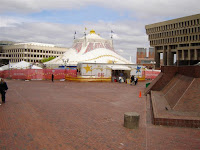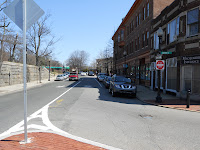 1
1  2
2  3
3  4
4...at least for now
Location: Government Center (formerly Scollay Square, and today alternatively called Boston City Hall Square or City Hall Plaza), Boston, MA. (MAP)
Year of Urban Fabric Restoration: Ongoing (April 2010).
The Photos: Taken on Patriots' Day 2010, looking northwest along the side of City Hall, then coming into the plaza and looking north and northeast at the Big Apple Circus tent.
The Story: So, we took the kids to the Big Apple Circus on City Hall Plaza last Friday night. We had a great time at a show of almost 2 hours in length, featuring the return of Bello Nock and a number of classic circus acts such as juggling, acrobatics, and (my personal favorite, especially now since we have a rescue puppy of our own) a dog act featuring (you guessed it) rescue dogs. Really fun stuff for the whole family.
But this entry is not about the circus itself, fun though it was. It's about the temporary life and activity and yes, restoration of the urban fabric, that can occur when even something as simple as a circus with a tent is brought onto City Hall Plaza. A plaza which has ripened into perhaps the most underperforming centrally-located public space in Boston, if not all of New England and if not the country. I mean, it's really bad, especially considering its proximity to so much great urban fabric and activity. I touched a bit on the plaza in the post about Boston's "mid-century modern" buildings a few weeks ago. It is truly of a piece with the failed buildings with whom it entered our cityscape in the mid-1960s. Most of the time it is a wind-swept, shade-less, inhospitable no-man's land that people hurry through to get from a dreadful MBTA headhouse for the Government Center Station
[especially when compared to what it replaced
 (CREDIT: http://www.bambinomusical.com/)]
(CREDIT: http://www.bambinomusical.com/)] to everything that surrounds the plaza -- Boston City Hall itself, Faneuil Hall/Quincy Market across Congress Street, the Old State House around the corner at the intersection of Court and Washington, the state government complex up the hill, and the federal government's buildings on the north side of the plaza. When you think of the number of people who go around and through it on a daily basis, it's something of a twisted accomplishment that the space is so dead.
This failed state of affairs at the very center of the city has not gone entirely unnoticed, especially in the last 10 to 15 years. Proposals have been floated and special task forces created to improve the plaza itself and make the buildings around it work better. After extensive discussion and effort from some of the city's most talented and influential citizens, there has been relatively little to show. Physically, all that has happened is the construction of a series of benches and small balconies along the Cambridge Street frontage with vertical, flagpole-like lighting elements (see photo 4, above). The only obvious programmatic progress has been a seasonal farmers' market that sets up just along that Cambridge Street frontage on certain weekdays in the summer. Most recently, the Boston Globe ran a piece about a design contest for ideas to better integrate City Hall itself into the urban fabric. The proposals highlighted are interesting and I do like the way the winning entry opens up the Congress Street side of the building and introduces a cafe at the lower plaza level.
Far be it from this blog to criticize incremental changes and developments like these. Yet the fact remains that chipping away at the edges is not doing enough to change the plaza's sub-par dynamic. To do that, something needs to be happening in the middle of the plaza on a consistent basis. Now, since the Patriots, Red Sox, and Celtics have all won titles in their respective professional leagues this decade, there have been 6 victory parades (the City likes to call them "Rolling Rallies") that have wound past and sometimes ended at City Hall Plaza, so that's brought some crowds onto the plaza. And the City has set up a few major events, sometimes for extended periods, on the plaza in the past several years. These have included not only the Big Apple Circus but also the Holiday Village that used to be at Jordan Marsh (then Macy's) at Downtown Crossing, and is now residing at one of Jordan's Furniture's suburban locations. These are good events, but relatively few and far between. So...a humble suggestion to the City, which may already be going in this direction...how about a simple, set schedule of extended engagements on City Hall Plaza for temporary uses that encourage people to come and spend some time and even spend some money in the very middle of town? Maybe the Big Apple Circus could be more firmly established as the rite of early spring, while late spring, summer and early fall could feature the existing farmers' market combined with the fledging Boston Public Market, which has been casting around for a home for the last few years, and seems always just a step away, but never quite there? They've most recently been in Dewey Square on two days a week during the summer. Despite the great foot traffic generated by its proximity to South Station and the need for the Greenway to have worthwhile programming, that location is really challenged, surrounded on 3 sides by multi-lane, one-way streets and on the fourth side by a utility building for the Big Dig. They can do better. Bring them to City Hall Plaza for an extended run in the middle of the year, get them to operate on more days, maybe even allow them to put up a temporary structure or two, and we'd really be talking. Once we're at the tail end of the fall harvest and the market is closed down, maybe we could have a temporary fair with rides and the like to lead us into winter. And then, who knows, the plaza hunkers down like the rest of us during the coldest part of the year and waits for the clowns, horses, acrobats, jugglers, Bello, Grandma, and the rest of the circus to come again in March?












